What Does a Typical Reporting Structure Look Like?
Table of contents
A reporting structure—sometimes known as employee structure—is how a company organizes and distributes responsibilities, including employee supervision. Every company is different, but let's break down the most common structure used at startups.

When you look at a company’s organizational chart, you are also looking at that company’s reporting structure. How a company organizes its people and distributes responsibility is a defining factor for its success.
Without the right structure, organizations can suffer from miscommunication, reduced productivity and inefficient workflows.
While it may seem pretty straightforward, there is not a one-size-fits-all approach to internal reporting structures. Finding the one that executes your business strategy and matches your company culture is an important step in building a business.
Get in front of millions of visitors and job seekers.
- Showcase your company culture to a vast community of professionals
- Host your team on a free org chart to keep employees aligned
- Post jobs on our free job platform for high growth startups
What is a company reporting structure?
A reporting structure—sometimes known as employee structure—is how a company organizes and distributes responsibilities, including employee supervision. The goal of a good reporting structure is to create a workflow that helps a company execute its business strategy and reach its goals.
A reporting structure can also help guide employees on who to turn to if they have questions, ideas or face challenges. Think of it as a roadmap to people and relationships inside your organization.
What is a typical reporting structure?
The most typical reporting structure is the hierarchical org chart. It’s the one that looks like a pyramid, and the one you are probably most familiar with.
In this structure, the person with the most responsibility (usually the CEO) sits at the top. Their direct reports make up the C-suite, and each C-suite executive runs their own chain of command.
Hierarchical structures are the most common because they are the easiest to visualize and are familiar to almost all employees. There are also different kinds of hierarchical structures that are more flexible and can adapt to a growing company.
What are the different types of reporting structures?
The five most common types of company reporting structures are:
- Hierarchical or vertical
- Functional
- Divisional
- Flat or horizontal
- Matrix
- Holocracy
Let’s break down the different types and go through how they might be a good fit for your organization.
Hierarchical
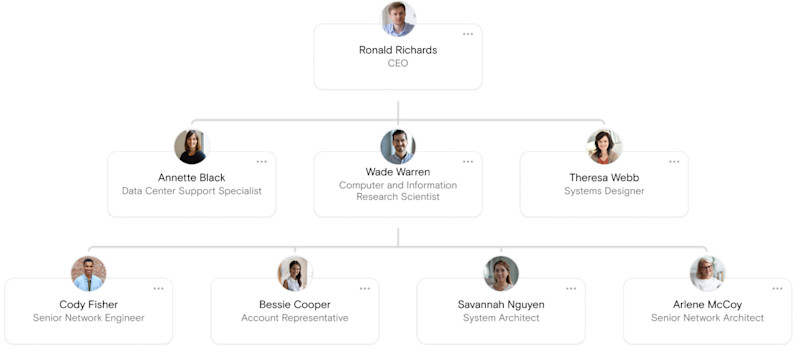
A traditional hierarchical structure looks like a pyramid with the CEO at the top, followed by C-level executives. These C-level executives are the ones who report to the CEO in this organizational structure. Each executive has their own direct reports, and the chain of command goes down from there. This is also known as a traditional vertical structure.
Pros:
- Clear definition of levels and authority
- Each person knows who they report to and who they can talk to about specific projects
- Motivates employees with clear career paths and chances for promotion
- Creates a sense of community with employees in the same department
Cons:
- Long chains of command increases bureaucracy and slows down innovation
- Slow speed of information can inhibit leadership’s ability to make quick decisions
- Lower level employees can’t easily express ideas and contribute to the whole company
- Employees can act in interest of their department rather than the whole company
Functional
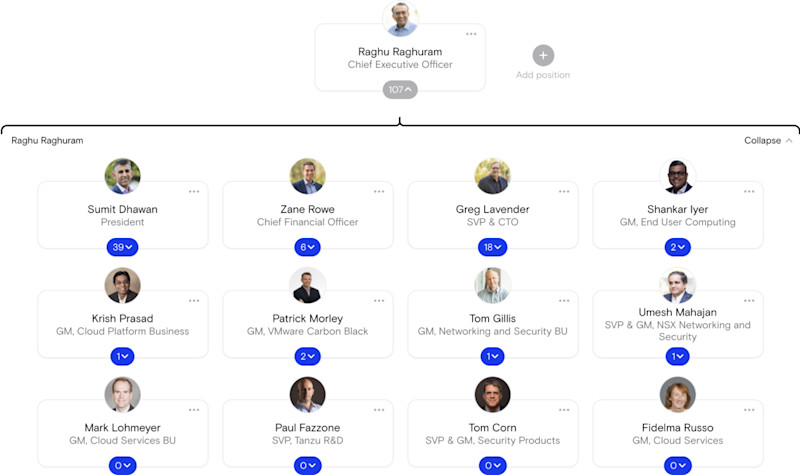
Similar to hierarchical, a functional reporting structure organizes employees into departments based on their functions or skills. Common functions include marketing, sales, operations, human resources and legal.
For example, a Vice President could have authority over the marketing, sales and business development teams.
Pros:
- Encourages specialization
- Easy to scale in a company of any size
- Allows employees to have greater focus in their tasks
Cons:
- Can create silos within organization
- Inhibits interdepartmental communication
- Obscures processes and strategies for different products or services within an organization
Divisional
Divisional org structures are separated by “divisions” which can include different markets, products or locations. This works particularly well for large companies (such as Walmart) that might want to separate its consumer goods from its logistics division.
These structures work differently from the others on this list because each division can have their own functional teams. For example, one market division may have their own marketing, sales or IT team that is separate from another division.
Pros:
- Divisions help large companies stay flexible
- Quicker responses within individual markets or to customer needs
- Promotes autonomy and independence within the divisions
Cons:
- Much easier to duplicate resources or costs
- Higher chance of miscommunication between divisions and the main company
- Can result in a company competing with itself
Here are three examples of divisional reporting structures.
- Market-based

Divisions split by markets are common in companies who have multiple brands or target markets for their products.
- Product-based
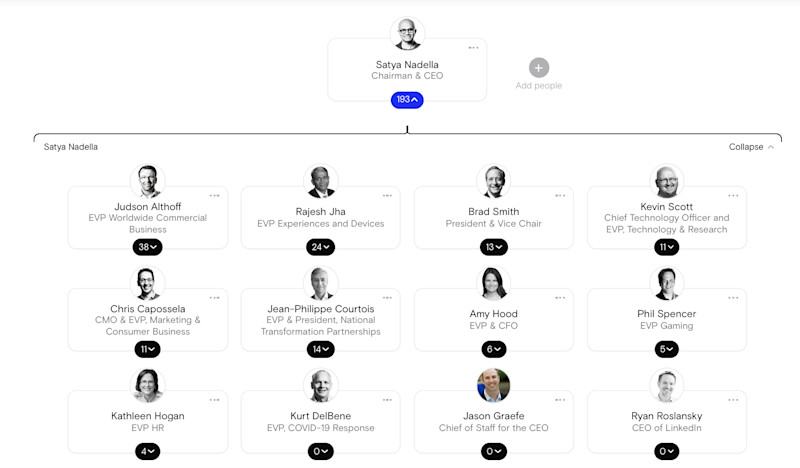
Product-based divisions are created to focus on different products. This is common in companies whose products require substantial research and development.
- Geographically based

Geographically based divisions are created based on different geographic regions. This can be global, such as the United States, Europe and South America, or can be national or local regions.
Flat
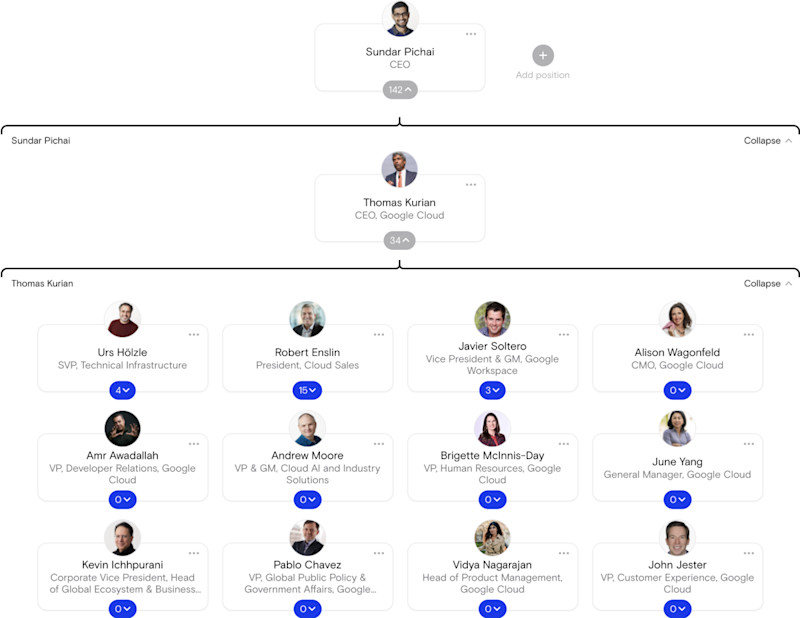
Also known as “horizontal” or “flatarchy,” flat reporting structures have little to no middle management positions, creating little distance between employees and company leaders.
Pros:
- Employees have much more responsibility and autonomy
- More open communication
- Faster speed of ideas and innovations
- Easy to understand
Cons:
- Don’t adjust well to growth
- Can produce employees with more generalized skills
- Can create confusion among employees without a clear supervisor to report to
*READ MORE: What are Flat Organizational Structures and How Do They Work *
Matrix
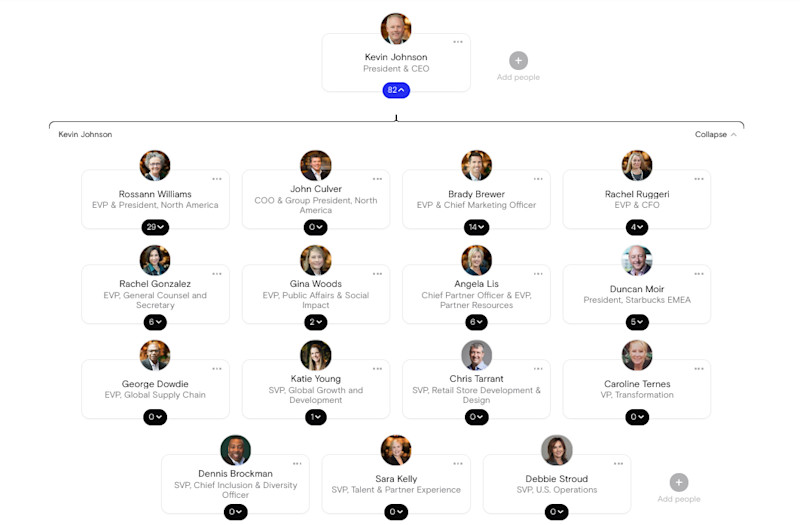
One of the most complex structures is a matrix org chart. Companies that follow a matrix structure involve two different reporting relationships for employees: one with product development and the other with their business function. Employees then report to a product manager and a business manager.
Pros:
- Encourages collaboration across teams
- Allows supervisors to easily choose employees based on the need for a project
Cons:
- Confusing lines of reporting
- Work can easily be duplicated or costly
- Can lead to conflict between two managers or employees
Holacracy

A holacracy is a decentralized reporting structure. It has self-managing teams that are responsible and accountable for their actions and decisions.
This is not a common structure as it can require radical changes. Zappos is one of the handful of companies that has shifted to this type of structure. They have adopted this structure to allow for a more distributed decision-making process. People can also work in departments where their talents are most useful.
Reporting to the CEO in a holacracy does not follow a structure. Instead, information is open, accessible and discussed during meetings. Small to medium-sized organizations can benefit from this type of company reporting structure.
How to choose the right reporting structure
In smaller startups, the reporting structure may seem obvious as everyone reports directly to the CEO or founder. But as a company starts to scale and more employees are hired, installing a framework of responsibility will become useful.
Consider the following before deciding on one or the other.
- Examine company goals and strategies
It’s always imperative to look at what you have now before you set something up for the future. Ask yourself what is your business strategy and what your workforce currently looks like. Carve out long term business goals and key business metrics. Think about what function of the business is most vital to reaching those long term goals.
- Consider how the company might grow
What's your company’s growth plan? How much will you realistically scale to in the next year, two years or five years? Consider a structure that will easily allow you to add new members and new responsibilities as you grow.
- Craft a transition plan
Once you’ve settled on a structure that fits your startup’s business strategies, visions and goals, it’s time to make a transition plan. Things to consider for a transition plan are:
- An accurate timeline of when you expect the new roles to start
- Expectations for supervisors and employees
- Handoff meetings between former supervisors and new supervisors
- Explanation of how the reporting structure is aligned with the business strategy and how it works best for the company
- Clear communication plan to the rest of the company. This should include a space for employees to ask questions
If you are working within a larger company, switching to a new reporting structure is an example of a reorganization—which includes a few extra things to keep in mind.
The easiest way to understand a reporting structure is to visualize it. Creating an org chart will give you a bird’s-eye view of exactly how your company is structured—and how it could be improved.
Just click here, and we’ll guide you through the process of setting up your very own org chart today.
Get in front of millions of visitors and job seekers.
- Showcase your company culture to a vast community of professionals
- Host your team on a free org chart to keep employees aligned
- Post jobs on our free job platform for high growth startups


The ORG helps
you hire great
candidates
Free to use – try today